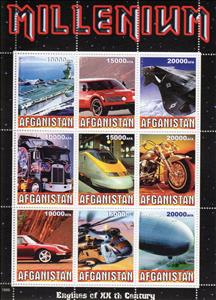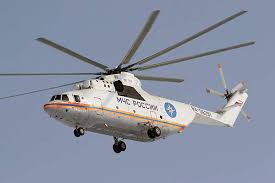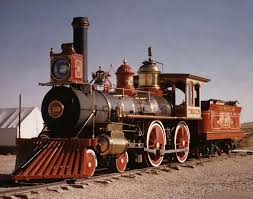Mini Sheet: Millenium - Engines of the 20th Century (Afghanistan 1999)
Millenium - Engines of the 20th Century (Afghanistan 1999)
01 January (Afghanistan ) within release Millennium (1999) goes into circulation Mini Sheet Millenium - Engines of the 20th Century face value 135,000 Afghan afghani
| Mini Sheet Millenium - Engines of the 20th Century in catalogues | |
|---|---|
| Colnect codes: | Col: AF 1999-22 |
Mini Sheet is square format.
Produced by the British counterfeit producer and still being distributed by associated counterfeit stamp dealers to this day. Avoid sellers of these!Also in the issue Millennium (1999):
- Mini Sheet - Millenium - Architecture of 9th-19th Century face value 135,000;
- Mini Sheet - Millenium - Art of 11th-19th Century face value 135,000;
- Mini Sheet - Millenium - Engines of the 20th Century face value 135,000;
- Mini Sheet - Millenium - Events & Famous People of 11th-19th Century face value 135,000;
- Mini Sheet - Millenium - Leaders of 9th-19th Century face value 135,000;
- Mini Sheet - Millenium - Movie Stars of the 20th Century Senior face value 135,000;
Mini Sheet Millenium - Engines of the 20th Century it reflects the thematic directions:
An aircraft (pl. aircraft) is a vehicle that is able to fly by gaining support from the air. It counters the force of gravity by using either static lift or the dynamic lift of an airfoil, or, in a few cases, direct downward thrust from its engines. Common examples of aircraft include airplanes, rotorcraft (including helicopters), airships (including blimps), gliders, paramotors, and hot air balloons.Part 1 (Definitions and Abbreviations) of Subchapter A of Chapter I of Title 14 of the U. S. Code of Federal Regulations states that aircraft "means a device that is used or intended to be used for flight in the air."
A car is a wheeled, self-powered motor vehicle used for transportation and a product of the automotive industry. Most definitions of the term specify that cars are designed to run primarily on roads, to have seating for one to eight people, to typically have four wheels with tyres, and to be constructed principally for the transport of people rather than goods. The year 1886 is regarded as the birth year of the modern car. In that year, German inventor Karl Benz built the Benz Patent-Motorwagen. Cars did not become widely available until the early 20th century. One of the first cars that was accessible to the masses was the 1908 Model T, an American car manufactured by the Ford Motor Company. Cars were rapidly adopted in the United States of America, where they replaced animal-drawn carriages and carts, but took much longer to be accepted in Western Europe and other parts of the world.
A helicopter is a type of rotorcraft in which lift and thrust are supplied by horizontally spinning rotors. This allows the helicopter to take off and land vertically, to hover, and to fly forward, backward and laterally. These attributes allow helicopters to be used in congested or isolated areas where fixed-wing aircraft and many forms of short take-off and landing (STOL) or short take-off and vertical landing (STOVL) aircraft cannot perform without a runway.
A locomotive is a rail transport vehicle that provides the motive power for a train. If a locomotive is capable of carrying a payload, it is usually rather referred to as a multiple unit, motor coach, railcar or power car; the use of these self-propelled vehicles is increasingly common for passenger trains, but rare for freight trains.
A millennium (pl. millennia or millenniums) is a period of one thousand years, sometimes called a kiloannum (ka), or kiloyear (ky). Normally, the word is used specifically for periods of a thousand years that begin at the starting point (initial reference point) of the calendar in consideration and at later years that are whole number multiples of a thousand years after the start point. The term can also refer to an interval of time beginning on any date. Millennia sometimes have religious or theological implications (see millenarianism).




